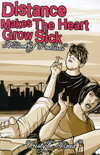Distance Makes the Heart Grow Sick
As the name implies, the DIY (Do It Yourself) movement is all about self-sufficiency. The punk branch of this larger concept pushes the ideology even further, basically shouting to all: “If your activities (aka consumer services or items) exploit planet Earth or creatures of, then f—k off! We’ll do it ourselves!” This model is essentially economic, finding new (and theoretically purer) paths around consumer culture, from music production (David Ferguson, Michelle Branch, etc.) to advertising (the very successful Sticker Junkie, among others) to the local farmer’s market or garage sale (or dare I say eBay?). DIY innately lends itself to the sensibilities of art and the internet: blogs, zines, forums, the arteries and chambers of the underground, of buzz, immediacy and verve – the hiss and crackle of punk.
As the name implies, the DIY (Do It Yourself) movement is all about self-sufficiency. The punk branch of this larger concept pushes the ideology even further, basically shouting to all: “If your activities (aka consumer services or items) exploit planet Earth or creatures of, then f—k off! We’ll do it ourselves!” This model is essentially economic, finding new (and theoretically purer) paths around consumer culture, from music production (David Ferguson, Michelle Branch, etc.) to advertising (the very successful Sticker Junkie, among others) to the local farmer’s market or garage sale (or dare I say eBay?). DIY innately lends itself to the sensibilities of art and the internet: blogs, zines, forums, the arteries and chambers of the underground, of buzz, immediacy and verve – the hiss and crackle of punk.
Author, illustrator, self-publisher, advocate for society’s underdogs, Cristy C. Road has been on the stiletto’s edge of self-authenticity and anti-authority for years, slicing and slashing her way forward. She is prolific (for a sampling I strongly suggest you visit her eclectic website of prose and drawings, CROADCORE). She is also consistent with angst as her subject. Road’s examination of alienation and anxiety goes beyond the simple teenage variety, the self pity that drives a young person to view the greater world and write about themselves. Instead, Road tackles edgier issues: sex and sexuality, mental illness, race, class, identity in the good ol’ (and often not so good ol’) U.S. of A. Clearly, Road maintains a larger view, a bit of Patti Smith, a touch of Banksy (before he sold out, right?), maybe even a shard of Valerie Solonas: grittier, more vividly political, and certainly more serious than any tear-stained diary.
Her new collection is an offering of 90 postcards. Actual postcards, perforated for easy removal and mailing: I should know – I’ve currently sent out 14 of them to friends and enemies. And what is a postcard to an artist? A formula of juxtaposition: A (an image) plus B (words) equaling C (the new and greater meaning of the two combined). Think of Rauschenberg’s infamous goat-and-tire installation; or this spring’s Dave Eggers art show (he was curator of the event), a collection of text and images together (more than 100, including works by Jean-Michel Basquiat, Leonard Cohen, R. Crumb, and Kurt Vonnegut). Apparently, Eggers didn’t ask Cristy C. Road to submit for the showing. Not that she would have agreed to, this reviewer would hope. Her art belongs elsewhere, in the alley outside the gallery, or possibly in the storm drain, alongside an empty bottle of codeine cough syrup.
Images of the underbelly, city dwellers clutching beer bottles, pills, and hand-rolled marijuana cigarettes, all hunched below an ashy urban sky. Of biker women. Glam rock men. Of one woman proudly walking the street while wearing a strap-on dildo (I sent this one to my grandmother but haven’t heard back yet). Of youth, droopy-eyed, sullen, in hoodies and mascara, thick belts and jangling chains, as they leap concertina wire, make out in public, lug their perfectly beaten guitars from street corner to warehouse to dive bar. Does some of this seem stock? From the stage of Rent, the hipster hangouts of East Village? Possibly, but Road frequently takes things further, to the new and often startling, and this is where the art rises from the page.
One card depicts a woman standing below a towering skyscraper. Ravens spiral down from a pearly sky, and peck at her open skull, the gray matter of her brain. She reads the newspaper, apparently oblivious to her exposed cranium, the “open mind” as carrion. We glimpse only the front and back page of the newspaper. The headline announces JUST SAY NO. The back is a full-page advertisement for vodka. Now this is an America I recognize. This is an image that makes me question.
Another card is a young woman in a jaundice yellow bathtub. She has taken the long metal tubing of the shower coil and appears to sexually service herself with the showerhead. Her legs are spread wide. Her expression one of orgasmic self-satisfaction. But most fascinating is the setting. Below the sink a pile of dirty laundry (metaphor anyone?). The bathroom rug resembles a tangle of steel wool. And, captured in silhouette against the window glass of the door, a man, his face buried in his hands, grieving. Him. Her. Their closeness. Their distance. The pale wash of the grimy wall mirror. There is truth enough here about relationships to fill several novels.
Several other images in this book contain such compressed honesty. Such exposure. Such a lot, on a relatively small canvas. And isn’t this the purpose of postcards? Finally, Road’s work surpasses the cliché, and the postcard embraces its form and function: to fly, to transfer – to communicate. A message sent, for all to view along its passage. And then received. To grant a voice. To speak: This is the art and life of Cristy C. Road.





